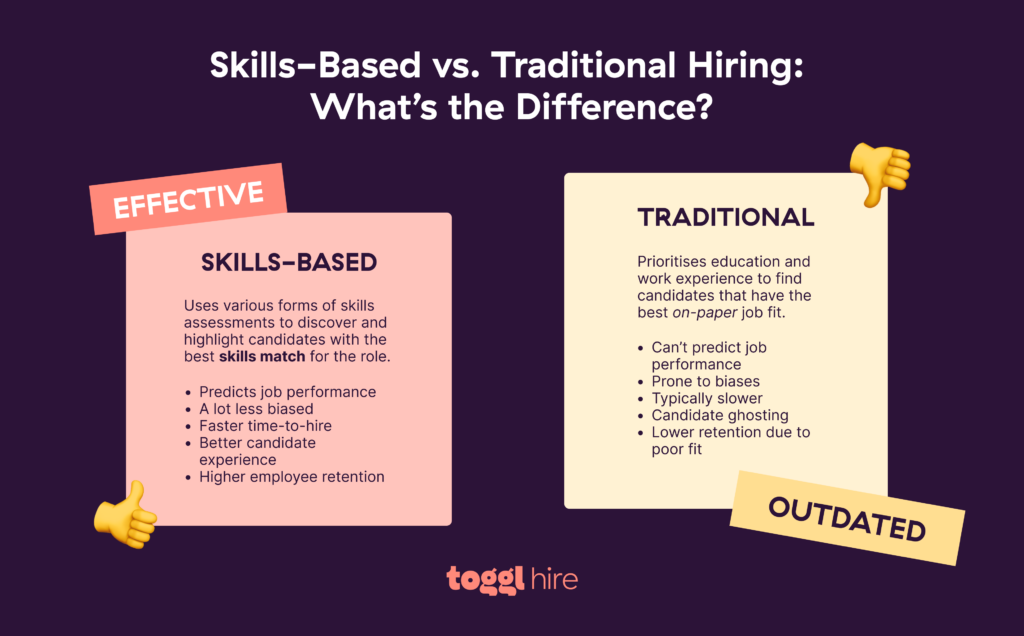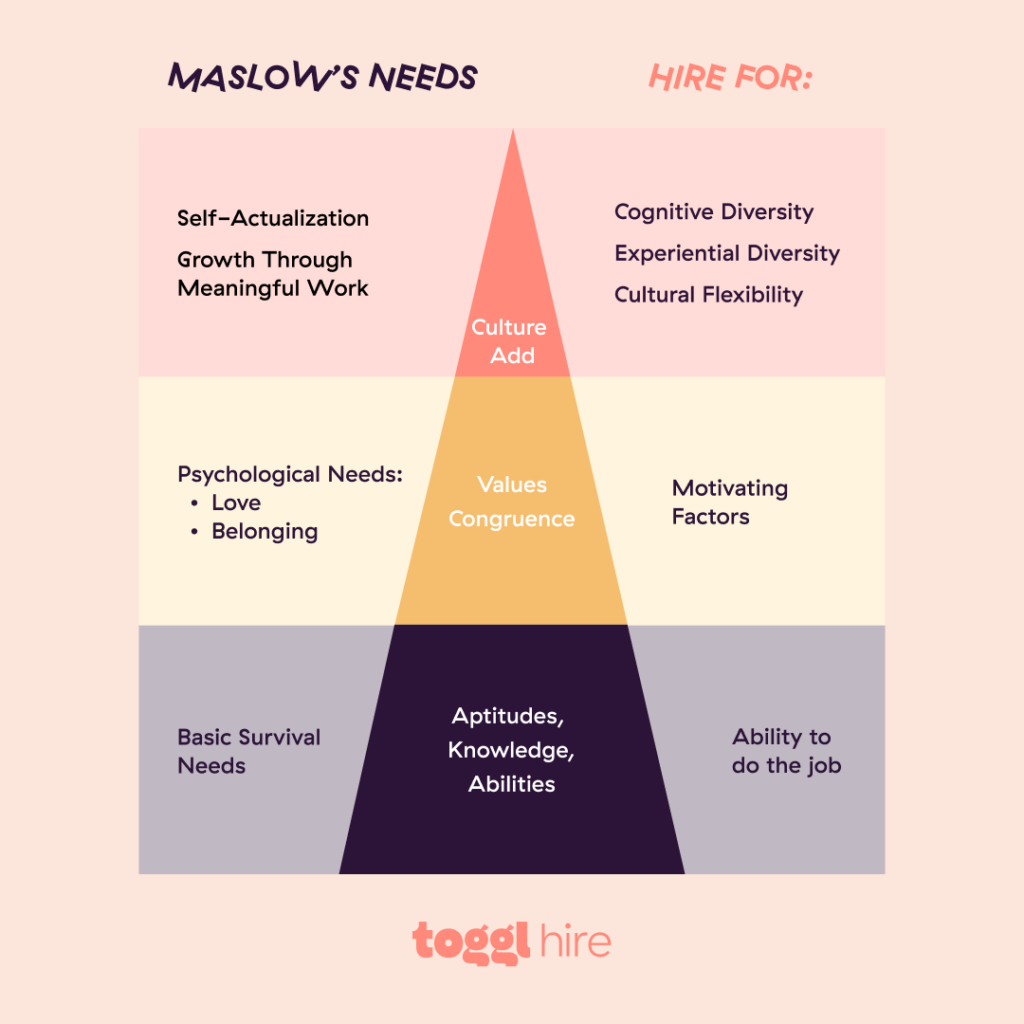47% of people think AI would be better at picking the right candidate for a job than humans. However, 71% oppose using AI in making a final hiring decision.
AI is transforming the way we work, but it’s not a silver bullet when it comes to recruitment. While it can help us speed up processes and alleviate repetitive tasks, hiring managers should use more proven, reliable methods when making hiring decisions.
Let’s explore why decision-making in recruitment is so challenging — and how to do it better.
TL;DR — Key Takeaways
Hiring decisions are difficult to make due to time pressure, many people applying to the same job, and long-winded resume and interviewing processes.
The ability of recruiters and hiring managers to work together is critical for a well-organized system and good candidate experience.
Before making the final decision, first define who you’re actually looking for. Then, identify the right tools to remove bias at every stage, like Toggl Hire’s full-cycle recruiting software.
Consider different factors, like skills assessments, to evaluate candidates objectively and look for culture addition rather than culture fit.
Why are hiring decisions so hard to make?
Choosing the best candidate is tricky for several reasons. In addition to overcoming unconscious bias, several other factors challenge the decision-making process:
There are soooo many applicants applicants. High-paying, fully remote hiring opened up the talent pool globally, increasing competition for the best positions. Remote positions typically have over 1,000 applicants. How do you find the diamond in the rough in a stack of resumes so high?
Assessing soft skills, like leadership, is challenging. It’s hard to get objective, data-driven insights into a candidate’s soft skills. Traditional screening tools, like reference checks or self-promotion in a cover letter, are, of course, subjective.
Time pressure to fill positions fast. 87% of companies worldwide are aware that they have a skills gap. The faster they can fill it, the faster they can outcompete the competition.
Avoid bad hires at all costs. We’ll discuss this in more detail below, but a bad hire can negatively impact your company’s morale, productivity, and budget.

Who makes the final hiring decision?
Hiring the right person is a team effort. It’s usually a collaboration between HR professionals and a hiring manager. At times, other team members might want to sit in on an interview to help determine if the candidate will be a good fit.
Traditionally, the HR professional or recruiter sources and screens candidates in the first step of the interview process. They’re trained in recruitment and know what makes a good candidate and culture fit.
The hiring manager will typically conduct more technical evaluations after this because they’re more familiar with the position’s day-to-day requirements and can, therefore, more accurately assess a candidate’s potential and hard skills.
For solid decision-making to happen, there needs to be a clear handover process between these stakeholders and a system for communicating their views on different candidates.
7 tips for making hiring decisions that’ll lead you to the right candidate
At Toggl, we’ve been hiring remotely for almost 20 years. Over the last several years, we’ve even built our own full-cycle hiring tool, conducted numerous user interviews, and compiled feedback from recruiters just like you.
Although we think it’s fair to say that we have some tips worth listening to when making the right hiring choices, we’ll let you be the judge. Browse our tips for finding the best candidate below.
1. Define your ideal candidate
Whether you’re a hiring manager or recruiter, one of the easiest ways to make a better hiring decision is to focus on skills and competencies.
What baffles us about the recruitment process is how some hiring teams decide on a hire without actually knowing (or testing) a candidate’s skills. To overcome that, you must go back to your initial candidate profile and the job description you’re hiring for.
Rather than focusing on years of past accomplishments, education, and pointless career awards, ask yourself:
What technical skills do they bring to the table?
What are their soft skills like?
Are they highly capable in what they do?
How will they fit in with the wider team?
To what extent does this match the responsibilities of this new position?
One important tip related to “ideal candidates” is not to get so granular that you overlook the right candidate because they aren’t “perfect.” If you aren’t sure your expectations are realistic, talk them through with someone who has been in or hired for that role in the past.

2. Remove hiring bias at every stage of your process
In a perfect world, all recruitment decisions would be made objectively, but in reality, we’re all riddled with unconscious biases. These biases lead us to favor one applicant over another based on factors other than their ability, increasing the risk of a bad hire and overlooking other qualified candidates.
The biggest issue we see that leads to bad hires? We love to hire mini-mes. In an interview, often, a person with the same background, age, race, or hobbies has a greater chance than someone different from the hiring manager.
This is one realm where AI can actually help your recruiting efforts. 68% of recruiters believe AI has the potential to mitigate unconscious biases. By abstracting a candidate’s personality characteristics and converting them into data points, you can make much more objective decisions.
However, algorithms trained on biased data will still give biased outputs. Another way around the unconscious bias issue is to involve multiple interviewers in the recruitment process to diversify perspectives.

3. Assess candidates objectively
If you’ve been following us for a while, you know we’re really not that big on resumes. Objective hiring methods give a more accurate and unbiased picture of your candidates. Make sure you’re being fair with one of these techniques.
Skills assessments: These let your candidates’ abilities speak for themselves. No chance to exaggerate something on a CV or impress with words. Give your candidates a relevant task and see if they have the hard skills to thrive in the position. Toggl Hire lets you do this with just a few clicks and then sorts your applicants by test score so you can instantly see the best candidate in seconds.
Structured interviews: Structured interviews are a great option if you’re not keen on assessments. Decide on a set of effective questions that objectively evaluate candidates’ suitability for the role, and ask them all in the same order to your prospective employees. This method gives every candidate the same chance to impress, making them easier to compare later.
Interview scorecards: Combine this with point 2 for a killer candidate evaluation mechanism. Interview scorecards allow you to assign candidates’ answers a grade to compare their scores. This helps you systematically assess candidates without relying too much on gut feeling.

4. Assess for cultural add, not culture fit
Sometimes, bad hires result from a mismatch in expectations or personalities. When interviewing candidates, assess this with the same weight as other skills and characteristics.
However, pay close attention to your candidate — are they a cultural fit or a cultural add?
Cultural fit:
Hinges on implicit bias
Matches existing work environment
Maintains the status quo of an organization
Might detract from diverse hiring, as the same types of people tend to fit in
Cultural add:
Welcomes new perspectives and ideas
Adds new value to company culture
Encourages the organization to evolve and grow
Favors diverse hiring, bringing in a multitude of complementary voices
To assess whether one candidate would be a good fit, consider adding thoughtful questions or exercises that reveal how their unique background can enhance and diversify the organization.

5. Evaluate for potential growth
Great candidates will show growth potential. Who can you see developing and pushing the company forward? Who is really paying attention?
Evaluate for things like:
Eagerness to learn
Adaptability
Problem-solving skills
Are they team players or lone wolves?
Enthusiasm for the company’s mission
These characteristics will help you identify employees who will keep up with the fast-paced nature of evolving technologies and the need for continuous learning in today’s competitive job market.

6. Re-structure your hiring process to use the power of data
We recommend using data and analytics to inform recruitment decisions, and others agree — 79% of recruitment teams now use some form of AI-driven recruiting, according to SHRM.
We’ve got a whole guide on creating a data-driven recruiting funnel, but in summary, here’s how you can make a positive change:
Track key metrics such as time to hire, time to fill, candidate source, and conversion rate to understand how your process is working. These will provide valuable insights into the effectiveness of your hiring process and show you which areas need attention.
Give candidates a fair chance to showcase their skills with skills screening tests. Instead of focusing entirely on the CV, flip the process on its head and use test scores to help you identify the best candidates.
Scale and standardize your interviews, including your interview questions, with interview technology such as one-way video interviews.
Click here to download a free copy of our recruiting metrics template! Don’t worry—we don’t ask for your email or anything. Just make a copy of the sheet and customize it to your own hiring cycle and needs.
7. Use the right tools to make data-driven hiring decisions
Having the right tools can make or break your hiring strategy. Tools like Toggl Hire, a full-cycle hiring software with built-in candidate assessment features, can help you make data-driven decisions at every step of the recruitment process, from sourcing and screening candidates to interviews and personalized communications.
Pymetrics is another great tool that uses AI and behavioral assessments to find the right fit. HireVue offers AI-driven video assessments that evaluate candidate responses, facial expressions, and speech patterns and then use predictive analytics to anticipate top talent.
BONUS: Don’t hire just for the sake of it
Have you ever made a bad hire? Admitting a mistake is one step toward making better choices.
Often, people end up hiring the wrong person because they’re desperate to fill the position. It’s a case of choosing the lesser of two evils — hiring someone who may not be a great fit or having a position remain unfilled for even longer.
Some interesting research from the team at AIHR found that the average time-to-fill is 36 days, with more complex roles extending up to 45 days.
As we’ve written before, the cost of hiring an employee can make a huge dent in your company’s budget. Additionally, making a bad hire can cost anywhere from 30% to 150% of the new hire’s annual salary.
If you take anything away from this article, it’s to never hire for the sake of it. It’s detrimental to your budget, reputation, and employee satisfaction. If you urgently need to fill a position, outsource it temporarily to a freelancer.
Use Toggl Hire to make difficult hiring decisions easy
Toggl Hire simplifies hiring and supports data-driven decision-making with automated skills assessments, real-time analytics, and detailed candidate profiles.
Our skills-based assessments provide concrete, quantifiable data about each candidate’s abilities.
Subject-matter experts and seasoned industry professionals have reviewed every assessment we offer.
Confidently back your choices with hard data, removing the guesswork from the equation and ensuring every hire is a strategic one.
Save time, reduce bias, and find the best candidates faster than ever with Toggl Hire. Sign up for a free account to see for yourself!
Julia Masselos is a remote work expert and digital nomad with 5 years experience as a B2B SaaS writer. She holds two science degrees Edinburgh and Newcastle universities, and loves writing about STEM, productivity, and the future of work. When she's not working, you'll find her out with friends, solo in nature, or hanging out in a coffee shop.









